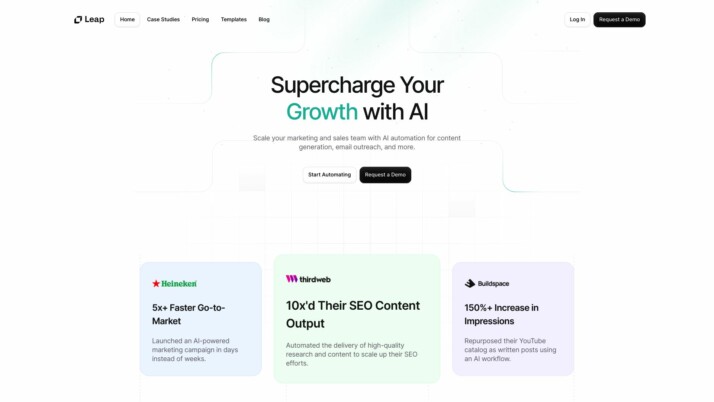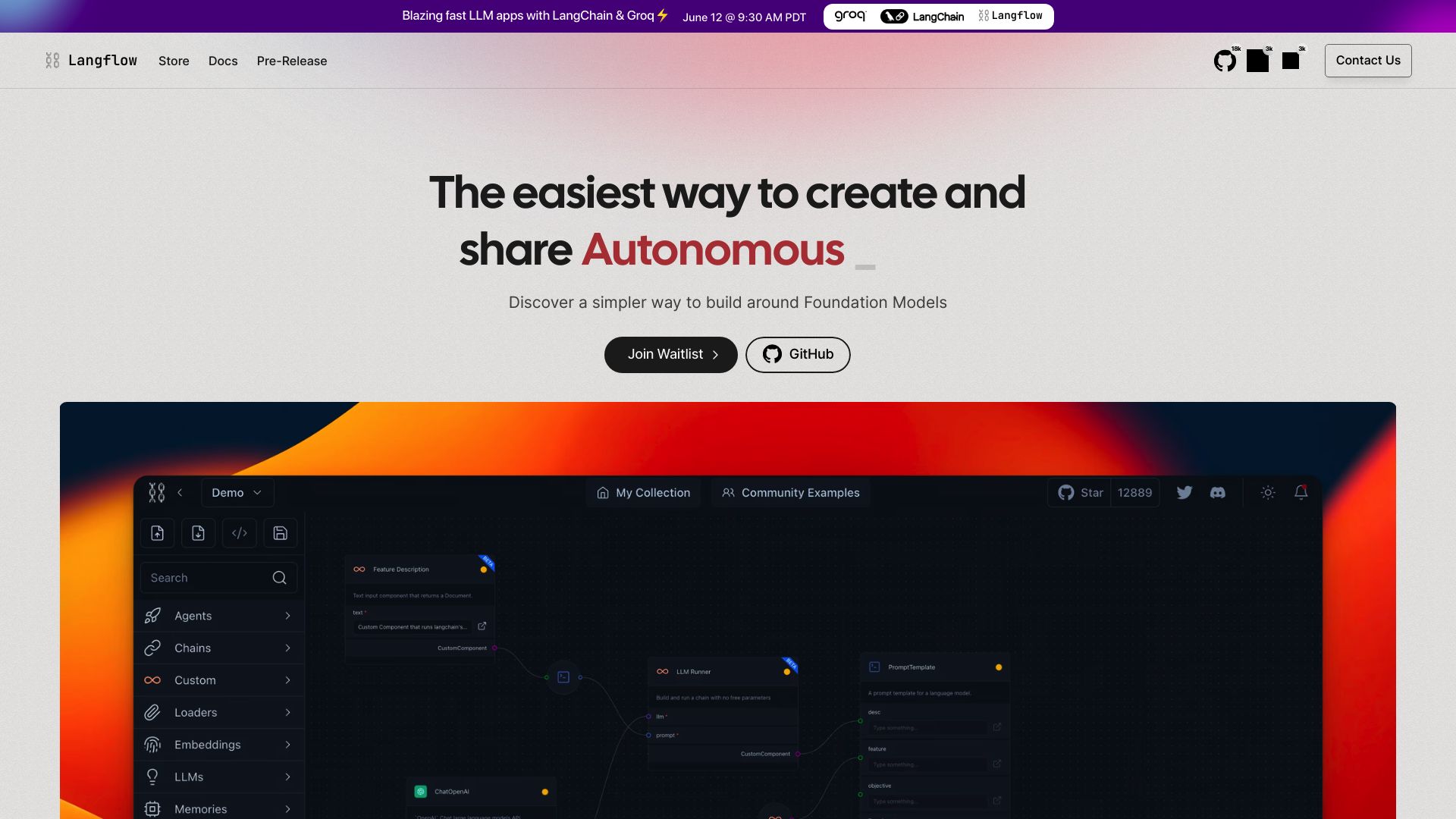Leap AI vs. Langflow: Comparing AI Agent Builders
AI agent builders revolutionize software development, empowering users to create intelligent applications without extensive coding. This comparison explores Leap AI vs. Langflow, two leading platforms in the AI agent builder space. We’ll examine their key features, development approaches, and security measures to help you determine which solution best fits your needs. Whether you’re a seasoned developer seeking granular control or a business user looking for rapid AI integration, understanding these platforms’ strengths and limitations is crucial. We’ll also introduce SmythOS, a powerful alternative that combines user-friendliness with advanced capabilities, offering unparalleled flexibility and scalability for AI agent deployment.
Leap AI Overview
Leap AI empowers users to create sophisticated AI workflows without coding expertise. The platform’s drag-and-drop interface allows rapid development of AI-powered applications, from blog post generators to music creators. Leap AI integrates seamlessly with popular AI models like OpenAI GPT and Stable Diffusion XL, offering a versatile toolkit for diverse AI tasks.


Screenshot of Leap AI Website
Leap AI empowers users to create sophisticated AI workflows without coding expertise. The platform’s drag-and-drop interface allows rapid development of AI-powered applications…
Leap AI’s strength lies in its comprehensive SDK support, enabling integration into various applications through RESTful API, TypeScript, and Python. The platform’s extensive template library accelerates development, providing pre-built solutions for common AI use cases. This approach significantly reduces the time-to-market for AI-driven projects.
The platform shines in its integration capabilities, connecting effortlessly with tools like Slack, Hubspot, and Zapier. This interoperability allows businesses to enhance existing workflows with AI, improving efficiency across multiple domains. Leap AI also offers custom model training, allowing users to fine-tune AI models with their own datasets for more accurate and specific outputs.
While Leap AI excels in user-friendliness and rapid development, it may face challenges in highly specialized or complex AI tasks that require deep customization. The platform’s focus on accessibility could potentially limit advanced users seeking granular control over AI model architecture. Additionally, as with any cloud-based AI solution, users should carefully consider data privacy and security implications when handling sensitive information.
Leap AI positions itself as a bridge between AI technology and practical business applications. Its approach democratizes AI development, making advanced capabilities accessible to a broader audience. This strategy aligns well with the growing demand for AI solutions across industries, from marketing to customer service. As AI continues to evolve, Leap AI’s ability to quickly incorporate new models and maintain its user-friendly approach will be crucial for its competitive edge in the AI agent builder market.
Langflow Overview
Langflow empowers developers to create AI applications without extensive coding. This open-source platform simplifies the process of building complex AI workflows through its intuitive drag-and-drop interface.


Langflow’s visual builder integrates pre-built LangChain components, allowing users to construct sophisticated AI agents and workflows visually. This approach democratizes AI development, making it accessible to both seasoned programmers and those with limited coding experience. The platform supports a wide range of AI tasks, from basic automation to complex language processing.
Langflow’s visual builder integrates pre-built LangChain components, allowing users to construct sophisticated AI agents and workflows visually.
Key features include secure authentication mechanisms, API integration capabilities, and the ability to create custom components using Python scripts. Langflow also offers a chat interface and embeddable widgets, facilitating the development of interactive AI experiences. While the platform excels in usability and flexibility, it may present a learning curve for complete beginners and might not match the granular control of high-code solutions for highly specialized needs.
Langflow’s vision centers on making AI accessible to a broader audience. By combining low-code simplicity with powerful customization options, it aims to empower users across various technical backgrounds to leverage AI technologies effectively in their workflows. As AI continues to evolve, Langflow strives to adapt and provide tools that align with the latest advancements and user requirements.
Feature Comparison
Leap AI and Langflow offer distinct approaches to AI agent development, with key differences in their core components and security features. Leap AI provides a user-friendly platform with a drag-and-drop interface and extensive template library, catering to users with limited coding experience. It excels in rapid development and integration with popular tools like Slack and Zapier. However, Leap AI lacks some advanced features present in other platforms.
Langflow, as an open-source solution, offers more flexibility for customization. It provides a visual builder for constructing AI workflows using pre-built LangChain components, appealing to developers who want granular control. Langflow supports custom component creation using Python scripts, enabling tailored functionality. However, it may present a steeper learning curve for non-technical users compared to Leap AI.
In terms of security, both platforms offer basic features like data encryption and OAuth support. Leap AI implements multi-layer encryption and provides audit logs for user activities. Langflow emphasizes secure authentication mechanisms, particularly useful for public deployments. However, neither platform appears to offer advanced security features like constrained alignment or comprehensive audit capabilities found in some enterprise-grade solutions. Users with stringent security requirements may need to carefully evaluate these limitations when choosing between Leap AI and Langflow for their AI agent development needs.
Feature Comparison Table
| Leap AI | Langflow | SmythOS | |
|---|---|---|---|
| CORE FEATURES | |||
| Hosted Agents (Dev, Production) | ❌ | ✅ | ✅ |
| Autonomous Agents | ❌ | ✅ | ✅ |
| Explainability & Transparency | ❌ | ✅ | ✅ |
| Debug Tools | ❌ | ✅ | ✅ |
| Problem-Solving Capabilities | ✅ | ❌ | ✅ |
| Multi-Agent Collaboration | ❌ | ✅ | ✅ |
| Work as Team | ✅ | ❌ | ✅ |
| Bulk Work | ✅ | ❌ | ✅ |
| Agent Work Scheduler | ✅ | ❌ | ✅ |
| SECURITY | |||
| Constrained Alignment | ❌ | ✅ | ✅ |
| Data Encryption | ✅ | ❌ | ✅ |
| IP Control | ✅ | ❌ | ✅ |
| COMPONENTS | |||
| Foundation AIs | ✅ | ❌ | ✅ |
| All other APIs, RPA | ✅ | ❌ | ✅ |
| Data Lakes | ❌ | ✅ | ✅ |
| DEPLOYMENT OPTIONS (EMBODIMENTS) | |||
| Deploy as API | ✅ | ❌ | ✅ |
| Production Domains | ✅ | ❌ | ✅ |
| API Authentication (OAuth + Key) | ✅ | ❌ | ✅ |
| Deploy as Site Chat | ✅ | ❌ | ✅ |
| Deploy as GPT | ✅ | ❌ | ✅ |
| DATA LAKE SUPPORT | |||
| Hosted Vector Database | ❌ | ✅ | ✅ |
| Sitemap Crawler | ✅ | ❌ | ✅ |
| YouTube Transcript Crawler | ✅ | ❌ | ✅ |
| URL Crawler | ✅ | ❌ | ✅ |
| PDF Support | ✅ | ❌ | ✅ |
Best Alternative to Leap AI and Langflow
SmythOS stands out as the superior alternative to Leap AI and Langflow for AI agent development. Our platform combines powerful features with unparalleled ease of use, making it the ideal choice for businesses and developers seeking to harness the full potential of AI automation.
We offer a comprehensive solution that addresses the limitations of both Leap AI and Langflow. While Leap AI provides a user-friendly interface, it lacks advanced features like autonomous agents and multi-agent collaboration. Langflow, though flexible, presents a steeper learning curve for non-technical users. SmythOS bridges this gap by offering intuitive visual building tools alongside robust customization options, catering to users of all skill levels.
SmythOS bridges this gap by offering intuitive visual building tools alongside robust customization options, catering to users of all skill levels.
Our platform excels in providing a wide array of deployment options, including API endpoints, website chatbots, and integration with popular AI platforms. This versatility allows users to seamlessly incorporate AI agents into their existing workflows and systems. Unlike Leap AI and Langflow, we support a comprehensive range of data sources, including PDF, Word, and TXT files, as well as web crawling capabilities, enabling more diverse and powerful AI applications.
Security and scalability are paramount in SmythOS. We implement advanced features like constrained alignment and data encryption, ensuring that AI agents operate within defined parameters and handle sensitive information securely. Our platform easily scales to meet enterprise-level demands, a critical factor often overlooked by other solutions.
By choosing SmythOS, users gain access to a future-proof platform that continually evolves to meet the latest AI trends and requirements. We empower organizations to create sophisticated AI solutions efficiently, driving innovation and productivity across various industries. With SmythOS, the possibilities for AI agent development are truly unlimited.
Conclusion
Leap AI and Langflow offer compelling solutions for AI agent development, each with unique strengths. Leap AI excels in user-friendliness with its drag-and-drop interface and extensive template library, making it ideal for rapid prototyping and businesses seeking quick AI integration. Langflow, as an open-source platform, provides greater flexibility for customization, appealing to developers who require granular control over their AI workflows.
However, SmythOS emerges as the superior choice, combining the best of both worlds while addressing their limitations. We offer an intuitive visual builder alongside powerful customization options, catering to users across technical skill levels. Our platform supports over 300,000 integrations, vastly outpacing competitors and providing unparalleled versatility for AI agent deployment.
SmythOS stands out with its “Create Once, Deploy Anywhere” philosophy, allowing seamless deployment across various platforms and services. This flexibility, combined with our robust security features and scalability, makes SmythOS the ideal solution for businesses of all sizes looking to harness AI’s full potential.
To experience the future of AI agent development, create a free SmythOS account today. Explore our diverse range of AI-powered agent templates to jumpstart your projects, or dive into our comprehensive documentation to unlock the full power of SmythOS. Transform your workflow and unleash AI-driven innovation with SmythOS — the ultimate platform for building and deploying intelligent agents.
Last updated:
Disclaimer: The information presented in this article is for general informational purposes only and is provided as is. While we strive to keep the content up-to-date and accurate, we make no representations or warranties of any kind, express or implied, about the completeness, accuracy, reliability, suitability, or availability of the information contained in this article.
Any reliance you place on such information is strictly at your own risk. We reserve the right to make additions, deletions, or modifications to the contents of this article at any time without prior notice.
In no event will we be liable for any loss or damage including without limitation, indirect or consequential loss or damage, or any loss or damage whatsoever arising from loss of data, profits, or any other loss not specified herein arising out of, or in connection with, the use of this article.
Despite our best efforts, this article may contain oversights, errors, or omissions. If you notice any inaccuracies or have concerns about the content, please report them through our content feedback form. Your input helps us maintain the quality and reliability of our information.
